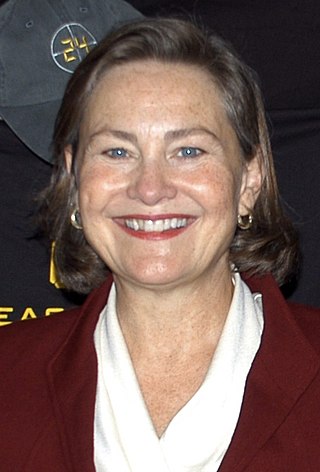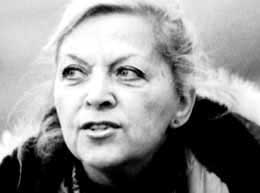Related Research Articles

Agnès Varda was a Belgian-born film director, screenwriter, photographer, and artist with French and Greek origins.

Barbara Jean Hammer was an American feminist film director, producer, writer, and cinematographer. She is known for being one of the pioneers of the lesbian film genre, and her career spanned over 50 years. Hammer is known for having created experimental films dealing with women's issues such as gender roles, lesbian relationships, coping with aging, and family life. She resided in New York City and Kerhonkson, New York, and taught each summer at the European Graduate School.

Cherry Jones is an American actress. She started her career in theater as a founding member of the American Repertory Theater in 1980 before transitioning into film and television. Celebrated for her dynamic roles on stage and screen, she has received various accolades, including three Primetime Emmy Awards and two Tony Awards, as well as nominations for an Olivier Award and a Screen Actors Guild Award.

Gwendolyn Audrey Foster is an experimental filmmaker, artist and author. She is Willa Cather Professor Emerita in Film Studies. Her work has focused on gender, race, ecofeminism, queer sexuality, eco-theory, and class studies. From 1999 through the end of 2014, she was co-editor along with Wheeler Winston Dixon of the Quarterly Review of Film and Video. In 2016, she was named Willa Cather Endowed Professor of English at the University of Nebraska at Lincoln and took early retirement in 2020.
Judith Crist was an American film critic and academic.
Mary Ellen Bute was a pioneer American film animator, producer, and director. She was one of the first female experimental filmmakers, and was the creator of some of the first electronically generated film images. Her specialty was visual music; while working in New York City between 1934 and 1958, Bute made fourteen short abstract musical films. Many of these were seen in regular movie theaters, such as Radio City Music Hall, usually preceding a prestigious film. Several of her abstract films were part of her Seeing Sound series.

Tala Hadid is a film director and producer. She is also a photographer. Her work has been shown at the Museum of Modern Art in New York City, The Walker Arts Center in Minneapolis, The Smithsonian National Museum, The National Museum of Women in the Arts in Washington D.C., L'Institut du Monde Arabe in Paris and other locations.

Storm de Hirsch (1912–2000) was an American poet and filmmaker. She was a key figure in the New York avant-garde film scene of the 1960s, and one of the founding members of the Film-Makers' Cooperative. Although often overlooked by historians, in recent years she has been recognized as a pioneer of underground cinema.
Courtney Hunt is an American Film director and screenwriter. She is best known for directing Frozen River, which won the Grand Jury Prize at the 2008 Sundance Film Festival, and was nominated for two Academy Awards.
Helen Victoria van Dongen was a pioneering editor of documentary films who was active from about 1925–1950. She collaborated with filmmaker Joris Ivens from 1925 to 1940, made several independent documentaries, and edited two of Robert Flaherty's films before retiring from filmmaking in her 40s.

Mildred "Chick" Strand was an American experimental filmmaker, "a pioneer in blending avant-garde techniques with documentary". Chick Strand contributed to the movement of women's experimental cinema in the early 1960s–1970's. Strand's film making and directing approach incorporates personal elements from her own life experiences and societal forces and realities. The film Elasticity (1976) is an example of Strand's attempts at autobiographical work that also incorporates Strand's specific standpoint on certain social issues. Feminist issues and anthropological inquiries about the human condition are frequent themes in Strand's films. However, because Strand's films and work were often deeply personal and subjective, they were often rejected from male-dominated academic circles of anthropologists and critiqued for being non-academic works.
Merata Mita was a New Zealand filmmaker, producer, and writer, and a key figure in the growth of the Māori screen industry.

Helen Eugenia Hagan was an American pianist, music educator and composer of African descent.
Elle-Máijá Apiniskim Tailfeathers is a Blackfoot and Sámi filmmaker, actor, and producer from the Kainai First Nation in Canada. She has won several accolades for her film work, including multiple Canadian Screen Awards.
Robin Anderson was an Australian award-winning documentary filmmaker.

Helen Clarissa Morgan was an American educator from the U.S. state of New York. She was the first woman to be appointed professor of Latin in a US coeducational college.
Irene Lusztig is a British-American nonfiction filmmaker and artist. Her work explores historical memory, archival materials, communism and post-communism, as well as feminist historiography.

Experimental animation is a form of animation in which motion pictures have their own rhythm and movement where it has no narration or a specific structure in animated films. It is considered to be subjective and non-linear that deals with philosophic and spiritual concerns that the artists and film-makers convey.
Bijou Amusement Company was a movie theater business in the United States. It was headquartered in Nashville, Tennessee. Its Bijou Theatre in Nashville was one of the premiere venues for African American audiences in the Southern United States. Milton Starr, who was part of the prominent Jewish family that owned and ran the theater, was the first president of the Theater Owners Booking Association (TOBA), headquartered in Chattanooga. Performers who starred at the theater included Bessie Smith, Mamie Smith, Ma Rainey, Lafayette Players, Butterbeans and Susie, Ethel Waters, and Irvin C. Miller’s Brown Skin Models. Boxers Tiger Flowers and Sam Langford had bouts at the venue. The theater and a Masonic lodge next door were razed in the 1950s as part of an urban renewal plan and replaced by the city’s Municipal Auditorium. The fight to save the theater reached the U.S. Supreme Court.
The Lincoln School for Nurses, also known as Lincoln Hospital and Nursing Home School for Nurses, and Lincoln Hospital School of Nursing, was the first nursing school for African-American women in New York City. It existed from 1898 to 1961. It was founded by Lincoln Hospital in Manhattan. The hospital and nursing school, moved to 141st Street, between Concord Avenue and Southern Boulevard in Mott Haven, the South Bronx, after 1899.
References
- 1 2 3 Williams, Deane Martin (May 29, 2016). "Interview with Cecile Starr". Framework: The Journal of Cinema and Media. 57 (1): 58–84. doi:10.13110/framework.57.1.0058. S2CID 190821545 – via research.monash.edu.
- ↑ "Cecile Starr Papers". www.columbia.edu.
- 1 2 "Starr, Cecile, 1921- - Social Networks and Archival Context". snaccooperative.org.
- ↑ "Collection: Cecile Starr papers relating to Mary Ellen Bute | Archives at Yale".
- ↑ "Cecile Starr Tribute Celebration". The New York Public Library.
- 1 2 "Starr, Cecile, 1921- - Social Networks and Archival Context". snaccooperative.org. Retrieved 2023-09-22.
- ↑ "Cecile Starr Interview — FRAMEWORK | The Journal of Cinema and Media". FRAMEWORK. Retrieved 2023-09-22.
- ↑ "Cecile Starr Interview — FRAMEWORK | The Journal of Cinema and Media". FRAMEWORK. Retrieved 2023-09-22.